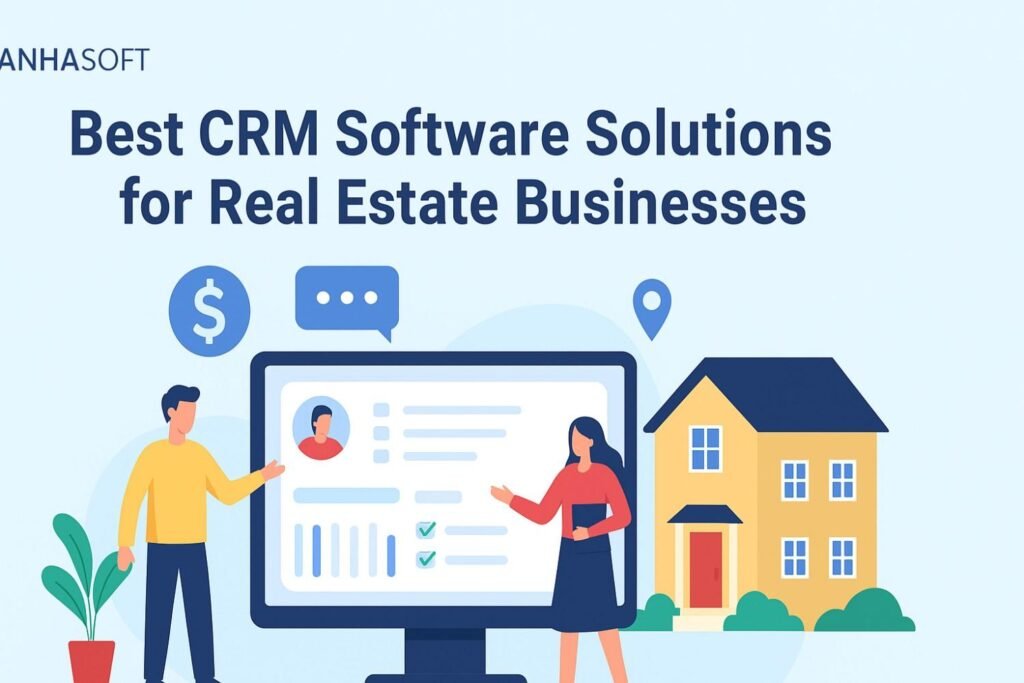At KanhaSoft we’ve seen more spreadsheets, sticky notes and coffee-fuelled late nights than any human should reasonably be proud of (and yet here we are). So when we talk about CRM software solutions for real estate businesses, we mean it—because we’ve been there, we’ve rolled up our sleeves, and yes, we’ve endured the “which folder did I save that lead in?” panic at 3 p.m. on a Friday (sound familiar?).
Let’s jump right in—after all, time is money and in real estate, seconds often mean lost deals.
What is a Real Estate CRM Software Solution?
A Real Estate CRM software solution is essentially a tailored customer-relationship-management system built (or configured) to meet the specific demands of property-based businesses: tracking leads, managing listings, nurturing follow-ups, handling vendor and buyer pipelines, and ideally automating the parts you wish you never had to do.
Think of it this way: if your business is a high-rise building, the CRM is the manager who keeps the elevators running, answers the phone politely and prevents the turf war between listing agents and showing agents (yes, we’ve witnessed that). When done well, the CRM becomes less of a tool and more of a teammate. (Yes—we said teammate.)
Why Real Estate Businesses Need Dedicated CRM Solutions
In real estate you don’t just deal with contacts—you deal with people, property, seasons, markets, emotions and occasionally the “I’ll think it over and call you back next Tuesday” loop. A generic CRM might suffice—if you’re happy with “good enough.” But when you’re working multiple listings, juggling buyer pipelines, coordinating open houses, tracking vendor relationships and analysing trends by area—well, that’s where real estate-specific CRM solutions shine.
Let us share a little anecdote: once we worked with an agency in Dubai (yes, UAE included) whose database was basically a shared Google sheet titled “Leads_RealEstate_FINAL_final_v2_v3”. You can imagine the chaos. Multiple agents, duplicate entries, mismatched status updates, and yes—the dreaded “we lost the deal because we forgot to follow up” call. We introduced a real-estate-specialised CRM and within three weeks that sheet was gone, follow-ups were scheduled automatically, and the team stopped inadvertently calling the same lead twice (yes—they’d done that). The difference was night and day—no exaggeration.
So yes: real-estate CRM software isn’t just nice-to-have—it is a strategic differentiator.
Key Features to Look for in Real Estate CRM Software Solutions
Selecting the best CRM software solutions for real estate businesses requires more than ticking boxes. Here are features that matter (we’ll admit we rub our hands when we find them):
-
Lead capture & routing: Automatically ingest leads from websites, portals, email, social media and route them to the correct agent or team.
-
Pipeline management: Visual dashboards that show where every buyer/seller is, what’s next, what’s stalled.
-
Listing management integration: Houses, apartments, plots—link them to leads, showings, offers and status changes.
-
Automated workflows: Reminders, follow-ups, scheduled emails—reduce the “Oops, I forgot to call” syndrome.
-
Communication logs: Calls, texts, emails—everything recorded, searchable. Especially helpful when a lead complains “you promised to call me back.”
-
Reporting & analytics: Areas, property types, agent performance, closing rates—because real estate is as much about data as it is about relationships.
-
Mobile access: Agents are rarely at desks—they’re showing properties, meeting clients, walking sites—so the CRM must follow.
-
Integration with other systems: Accounting, marketing automation, MLS feeds, geography-based tools (USA, UK, Israel, UAE—we’ve seen different needs).
-
Scalability and customisation: One size rarely fits all—your neighbourhood is different from another, your team size is different, your vendor network is different.
If any CRM claims “works for everything, installs in five minutes, costs nothing”—we’d say proceed with caution. (Yes, we have satire in our arsenal.)
Top Real Estate CRM Software Options (Overview)
Here we won’t endorse one product over another (because that’s not our style) but we’ll list the kinds of options you’ll encounter when you search for best CRM software solutions for real estate businesses. Choose wisely, ask questions, test.
On-the-Shelf SaaS CRMs
These are ready-to-go, minimal customisation required: “plug in, go live”.
-
Advantage: fast start, predictable pricing.
-
Trade-off: may lack deep real-estate-specific workflows or may require adapting your processes to tool limits.
Customised CRM Platforms
Here we (ahem) excel. Custom builds or heavily customised platforms by firms like ours.
-
Advantage: built exactly for your business model, workflow, region, listing-types, reporting needs.
-
Trade-off: higher initial investment, longer implementation.
Hybrid Approach
Use a good SaaS CRM as base, and partner with a developer (yes, like KanhaSoft) to extend or integrate with real-estate modules, local market feeds, API to your listing services. Balanced approach.
How to Evaluate CRM Options for Real Estate
Selecting the CRM is like choosing a rental property: location matters, features matter, cost matters—and you’ll live with it for years. Here’s how we recommend evaluating (yes, we borrow from our development-project checklist):
| Step | What to do | Why it matters |
|---|---|---|
| Map your processes first | Document how you work: lead sources, showings, offers, closings, post-closing follow-up. | Without understanding how you operate, any CRM will feel like forcing a square peg into a round hole. |
| Define must-have vs nice-to-have | Real estate has its core (lead capture → pipeline → closing) and then bells and whistles. | Prevents feature-creep and budget-blowout. |
| Ask for real-estate use-cases | How does the CRM handle multiple listings, territories, agent assignment, duplicate leads, buyer/seller mix? | Ensures the tool speaks your language. |
| Test mobile usage | Try it on smartphone, on site. Ask: how quickly can an agent update status? | If the mobile experience is poor, adoption will suffer. |
| Check integration & data migration | What happens to your existing data? Can you import listings, leads, contacts? | Avoid the dreaded “we lost our history” scenario. |
| Consider cost vs value | Not just license fees—also training, support, customisation, maintenance. | A cheaper tool might cost more in lost deals. |
| Evaluate vendor & support culture | Especially if you’re going custom: Is the firm responsive? Are they familiar with real estate? | We’ve seen plenty of projects drag because vendor didn’t “get” the business. |
| Plan for growth | If you scale to new regions (UK, USA, UAE, Israel) or add business lines (rentals, commercial), will the CRM handle it? | Scalability avoids future migrations. |
Why KanhaSoft’s Approach to CRM for Real Estate Stands Out
(Yes, this is where we toot our own horn—but quietly, and with a wink.) At KanhaSoft we don’t just deliver “CRM software solutions” we deliver real-estate-aware CRM software solutions. What does that mean?
-
We have direct experience building custom CRM applications for multiple domains including real estate (see our profile). ContactOut+1
-
We believe in “Build lean. Scale smart.” (Our internal mantra) — which means we focus on core value, avoid unnecessary bloat.
-
We favour transparency, collaboration and yes—coffee-powered late nights when deadlines loom.
-
We tailor for your market (USA, UK, Israel, UAE) so we understand listings, regulation, local workflows, language nuances.
-
We deliver more than code: we deliver workflow refinement. Because installing a CRM isn’t enough—you must adapt your processes too.
When we once helped a boutique real-estate firm in the UK adjust to market volatility, we didn’t just hand over software—we walked their agents through new automation rules, cleaned up lead duplication (ouch, that hurt), and saved them four hours per week per agent. Which meant more time showing properties. And that meant more revenue. So yes—our claim: “Transform your processes—transform your future” holds up.
Common Real-Estate CRM Mistakes (and How to Avoid Them)
Because yes—honesty: we’ve seen many CRMs mis-fire. Here are common pitfalls and how to sidestep them (you’re welcome).
Mistake: Choosing a CRM first, then trying to fit your process into it.
Avoid by: Map your process first. Then choose or customize the CRM to fit you.
Mistake: Ignoring agent adoption & training.
Avoid by: Engage your team early, show benefits (yes—they want fewer tasks, not more), provide training, incentives. We once had an agent threaten to revert to spreadsheets—until we showed them how mobile updating saved time.
Mistake: Letting duplicate leads proliferate.
Avoid by: Implement rules for lead de-duplication, standardized lead capture and assignment. Trust us, nothing kills morale like two agents calling the same lead and both saying “I got there first”.
Mistake: Focusing only on new leads, neglecting pipeline & post-closing nurture.
Avoid by: Use the CRM to track every stage—buyer, seller, closed deal, referral potential. A closed deal isn’t the end—it’s the beginning of the next.
Mistake: Overlooking data migration & historical records.
Avoid by: Plan import of old leads, deals, contacts so the CRM becomes the single source of truth. Otherwise you risk losing context.
Mistake: Underestimating mobile / offline needs.
Avoid by: Ensure your CRM works well on‐site, in poor connectivity conditions, on tablets/phones. Because yes—your agents aren’t always in an office.
How to Roll Out a Real-Estate CRM Without Causing a Revolt
Yes—we’ve done roll-outs when the coffee is cold and the deadline looms. Here’s our gentle (and slightly sarcastic) guide to launching your CRM smoothly:
-
Start with a pilot – Pick one team or territory, implement the CRM, refine workflows, fix bugs, collect feedback.
-
Communicate early & often – Help agents understand the “why”: less grunt work, more showings, better deals.
-
Train thoroughly (and with humor) – We find that humour helps: “Yes, this tool won’t send you to voicemail jail.”
-
Prepare data – Clean up existing spreadsheets, remove duplicates, standardise fields. Remember the “Google sheet chaos” anecdote above.
-
Go live and monitor – Track adoption metrics (log-ins, updates, pipeline movements). Provide support and rewards.
-
Iterate fast – Don’t launch and forget. Get feedback, tweak workflows, adjust settings—then repeat.
-
Scale slowly – Once the pilot is stable, roll out across the business, region by region. Change too fast and you risk revolt.
-
Celebrate wins – Share when an agent closed a deal because the CRM reminded them to call. Reinforce the value.
Measuring Success: Metrics You Should Track
Because if you can’t measure it, how do you know it’s working? (Yes—we’re circling back to dashboards.) Here are real-estate-specific metrics your CRM should make visible:
-
Number of new leads by source (portal, website, referral, walk-in).
-
Lead conversion rate (from lead to showing, to offer, to close).
-
Average time from lead to first contact.
-
Pipeline value by agent, territory, listing type.
-
Number of touchpoints before closing (calls, emails, meetings).
-
Agent adoption rates (logins, updates, tasks completed).
-
Client satisfaction or NPS (post-closing follow-up tracked).
-
Repeat business / referral rate (because closed makes more closed).
Monitor these regularly. When you see improvements (e.g., time to first contact drops, duplicates fall, conversions rise) you know the CRM is doing its job.
Tailoring CRM Solutions for Global Real-Estate Businesses
Our clients span USA, UK, Israel, UAE and beyond. So we know the nuances:
-
In the USA, integration with MLS, compliance rules, state-specific licensing matter.
-
In the UK, emphasis on lettings, property management, region-specific tax rules.
-
In Israel, language support (Hebrew/English), regulatory transparency, fast-moving market conditions.
-
In the UAE, multiple languages (Arabic/English), vendor-client relationship tracking, and sometimes cross-border investors.
If you’re operating globally, your CRM must support multi-language, multi-currency, regional workflows, mobile agents across time‐zones and consistent reporting. A generic CRM may suffice—but customised solutions help you stand out. (Yes, we keep saying that—but because it’s true.)
Emerging Trends in Real Estate CRM Software
We don’t just build software—we observe what’s coming. Here’s a sneak peek at trends in real-estate CRM solutions:
-
AI-powered lead scoring: Using patterns to prioritise leads that are more likely to convert.
-
Chatbot / conversational interfaces: Engage leads instantly via mobile or web chat, then route into CRM.
-
Mobile-first workflows: Agents expect full CRM capabilities on tablet/phone—not just read-only dashboards.
-
Integration with property marketing tools: Virtual tours, 3D floor-plans feeding data back into CRM (showings logged automatically).
-
Data-driven insights: Heat-maps of listing activity, agent performance, client behaviour trends.
-
Predictive analytics: Which listings will close quickly? Which leads are drifting? Which markets will surge?
-
Personalisation at scale: Automated nurture journeys for buyers and sellers—without losing the “human touch”.
At KanhaSoft we’re already building custom modules for these features—and we’ve seen early adopters gain real advantage. If you’re reading this and thinking “Hmm… maybe we should be exploring that”—you’re not alone.
Choosing the Right Partner (Not Just the Right Software)
Because at the end of the day, the software is only as good as the partner who builds, implements and supports it. Here’s what we believe matters when you pick a CRM vendor or developer:
-
Domain experience: Do they understand real-estate workflows, not just generic CRM?
-
Customisation capacity: Are they willing (and able) to tailor the system to your way of working?
-
Support & training culture: Will they help you adopt, not just launch?
-
Technical transparency: Can you access data, integrate with other tools, export when needed?
-
Scalability mindset: Will the solution grow with you, across markets, across business lines?
-
Clear pricing & timeline: Avoid hidden costs, surprises, “additional modules” after go-live.
-
Empathy and sense of humour: Because yes, things will get messy. A partner who can laugh and iterate with you is gold.
We like to think we tick these boxes at KanhaSoft (modesty aside) because we’ve lived the cycle: the mis-implementations, the abandoned CRMs, the “we thought this would save time but it created more tasks” stories. We fix those.
Implementation Checklist for Real-Estate CRM Roll-out
To wrap this section up, here’s a straightforward checklist that you can print, stick on your office wall and review (yes, we believe in visual reminders):
-
Map current lead-to-close workflow (including listing side)
-
Define CRM goals (less duplicates, faster follow-up, higher conversion)
-
Define must-have features + nice-to-have features
-
Shortlist CRM options (SaaS, custom, hybrid)
-
Request demos with real-estate agents doing real tasks
-
Clean & prepare data for migration
-
Train users (mobile + desktop)
-
Go live with pilot team
-
Monitor key metrics (conversion, time to contact, adoption)
-
Refine workflows based on feedback
-
Roll out broadly
-
Celebrate early wins and track ongoing ROI
So, What Should You Do Next?
If you’ve read this far (good on you), here’s a quick action plan—with our usual dash of KanhaSoft wit.
-
Grab a coffee (or tea, if you’re in the UK or UAE) and gather your team.
-
Ask: what’s the biggest pain-point in your real-estate business right now? (Write it down.)
-
Check: does your current CRM (or lack thereof) remedy that pain-point?
-
If no—or “sort of”—then schedule a test of a real-estate-specific CRM (or talk to us about customising one).
-
Don’t wait for “perfect”—pick something that moves the needle, then refine.
Because in real estate, speed and agility matter. Leads don’t wait, markets shift, listings expire. A reliable CRM is your co-pilot in the race.
Final Thoughts
At KanhaSoft we’ve seen the chaos of ad-hoc systems, the frustration of lost leads, and the relief that comes when everything finally clicks. Best CRM software solutions for real estate businesses aren’t about being flashy or trendy—they’re about doing the job, smoothly, reliably, elegantly. If your business is still using spreadsheets, sticky notes and “I’ll remember to call him tomorrow” conversations—well, you’re one step behind. And by the way—yes, we still love a good spreadsheet joke. But we also love when the joke becomes “We closed another deal because the CRM nudged the agent just in time.”
So let’s end this with our trademark (quiet) flourish: Transform your processes—transform your future. And yes, if you ever want to chat about leads, listings or beans (coffee beans, obviously) we’re here.
Until next time—stay nimble, stay focused, and may your pipeline always be full (of qualified leads, not confusion).
FAQs About Real Estate CRM Software Solutions
What is the average cost of a real-estate CRM software solution?
Costs vary widely: for a basic SaaS plan you may pay monthly per-agent; for custom solutions you may invest tens of thousands upfront plus ongoing support. Consider total cost of ownership (licence + training + migration + support).
Can I migrate my old lead data into a new CRM?
Yes—most good CRM systems allow import of spreadsheets, CSVs or database exports. But you’ll want to clean duplicates, standardise fields and test a sample before full migration.
How long does it take to implement a real-estate CRM fully?
It depends. A simple SaaS setup can be live in weeks; a customised roll-out might take 2-6 months (or more) depending on scope, integrations and training.
Will a CRM replace the need for good sales skills?
Not at all. A CRM enhances and supports your sales team—but it doesn’t replace the human connection, the property knowledge, or the closing finesse. The magic still happens between agent and client. The CRM just makes sure you don’t drop the ball.
What are the most common mistakes when selecting CRM for real estate?
See the earlier section—but summarised: picking a generic tool without real-estate features, neglecting training & adoption, ignoring mobile needs, and underestimating data migration challenges.
How do I measure if the CRM is successful?
Track metrics like lead response time, conversion rates, pipeline value per agent, duplicates reduction, agent adoption rate, and ultimately the number of deals closed (and referral business). Improvements here mean success.







